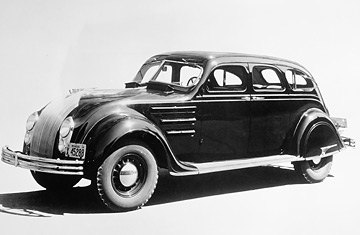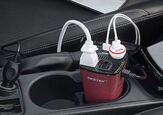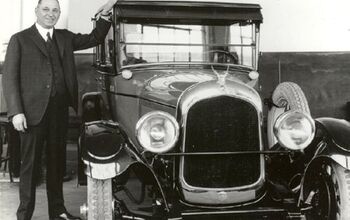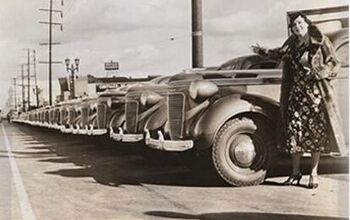Chrysler Suicide Watch 50: RIP

Chrysler’s logo should have been a bottle of lithium, rather than the Pentastar. It suffered from severe bipolar disorder all its life, and, sadly, died from it at its own hands. Like many suicidal bipolars (e.g., Van Gogh, Hemingway, Virgina Woolf), Chrysler’s many crashes and acts of self-mutilation were punctuated by fantastic highs of brilliant engineering, design and creativity. Chrysler has taken us on quite the roller coaster ride. And now it’s over. As we stumble out of our (Hemi-powered) coaster car, we’re left with an intense mixture of relief, thrill, and sadness.
Chrysler’s beginning was an unparalleled flash of genius and overnight success. Walter P. Chrysler had a fairy-tale career in the early automobile business, earning $10 million ($130 million today) in just three years while turning Buick into GM’s early powerhouse. Then, while running Maxwell, he launched the Chrysler line in 1924 with that just-perfect blend of advanced engineering and style.
It was a home run that catapulted Chrysler to number four out of a crowded field of 49 manufacturers. The subsequent successful launches of the low-price Plymouth, the upper-mid priced DeSoto, and the purchase of mid-priced Dodge firmly established Chrysler as a charter member of the Big Three.
Chrysler’s first crisis came in 1934 with the failure of the radically advanced but unusual-looking Airflow. Its wholesale rejection by the buying public taught Chrysler (and Detroit) a painful lesson: avoid extreme innovation.
Chrysler recuperated and made enormous profits during the WWII era. But the development of the all-new 1949 models was haunted by Chrysler’s still-lingering Airflow insecurities. Whereas GM and Ford confidently introduced longer and lower models designed to thrill exuberant post-was buyers, Chrysler president P. T. Keller insisted on tall, boxy cars.
In the early fifties, Americans were in the mood for more—horsepower, automatics, power steering and brakes, style, and flash. Unlike Chevy and Ford, Plymouth offered none of those, and the market punished it unmercifully. In 1954, Plymouth was kicked out of its long-established number three spot by Buick and dropped to number five behind Pontiac.
The exuberant designer Virgil Exner was hired to inject vitality and fresh style. The 1955s were an improvement, but the radical 1957s were destined to be the great leap forward (“suddenly it’s 1960!”). But in the rush to revolutionize, the products were not fully developed, and suffered from atrocious build quality.
The flashy ’57s sold, but word got out and buyers punished Chrysler unmercifully. 1958 sales plunged by no less than 41% for Plymouth. And despite a reputation for engineering excellence, Chrysler would have to dodge a reputation for spotty build quality from then on, deserved or not.
Chrysler nursed itself to health once more, only to be deeply wounded by one of the most staggeringly idiotic acts of executive self-mutilation. In 1960, Chrysler president William Newberg overheard a rumor at a cocktail party that Chevrolet was working on a dramatically smaller 1962 model (it was: the compact Chevy II).
In a colossal blunder, he assumed this referred to the full-sized Chevrolets. Newberg killed development of the full size 1962 Plymouths and Dodges and initiated a crash program for substantially downsized replacements. When the ugly, truncated ’62s were first shown to dealers, an uproar ensued, and twenty dealers cancelled their franchises on the spot. Plymouth crashed to ninth place, while GM’s market share rose to an all-time peak of 52%.
Chrysler barely survived the fiasco but went on to enjoy a relatively long spell of good health from the mid-60s through 1974, in part thanks to its successful performance image. But with a portfolio of heavy RWD cars and lacking the foresight, will (and capital) to retool extensively, Chrysler was flattened by the one-two punch of the energy crises. By 1979, it was back on the critical list, saved from bankruptcy only by the life-support of a government loan-guarantee act.
This financed the compact K-car; Chrysler squeaked by and regained health, once again. Endless K-car variants carried the day. When the 1990 recession brought on another depression, Iaccoca was shown the door.
In the mid-nineties, Chrysler was on its ultimate manic high. Low overhead costs from its near-bankruptcy, some deft model development, the purchase of Jeep, and sheer luck (the boom of the truck and SUV markets) generated huge profits and a 23% market share in 1997 (bigger than GM’s recently). But at the very height of health and success, the suicidal urges return.
In 1998, CEO Robert Eaton had Chrysler engage in ritual corporate seppuku by selling itself to Daimler (while walking away with over $200 million himself). And despite all of Dr. Z’s ministrations, the patient never really regained lasting health. Was there arsenic in the Daimler medicine?
There’s a market for corpses, and Cerberus bit with all three heads at once. And choked.

More by Paul Niedermeyer
Latest Car Reviews
Read moreLatest Product Reviews
Read moreRecent Comments
- Normie Dayyum! Great White Woman!The car, I mean. I could feel kinda safe in it.
- Slavuta "The telescreen received and transmitted simultaneously. Any sound that Winston made, above the level of a very low whisper, would be picked up by it; moreover, so long as he remained within the field of vision which the metal plaque commanded, he could be seen as well as heard. There was of course no way of knowing whether you were being watched at any given moment. " --- 1984
- Kjhkjlhkjhkljh kljhjkhjklhkjh ""The 10L1000 transmissions are built by GM and vetted by Allison"" .. ewww for tranny? your not losing anything killing the brandingThe term "10L1000" refers to the Allison 10L1000 10-speed automatic transmission, used in 2020 and newer heavy-duty GM Silverado and Sierra trucks with the Duramax 6.6L diesel engine. It is a heavily modified version of a jointly developed Ford/GM 10-speed platform, engineered by Ford with Allison branding and designed to handle increased torque and offer better fuel economy compared to its predecessor, the 6-speed Allison 1000.
- Wantahertzdonut Among my parent's friends (all engineer/teacher couples), they were friends with one couple that stood out because they were legitimately cool people. They had a 900 and I'll never forget getting a ride back from dinner on hilly roads in western NY in 1989. Everyone else had some rusty penalty box of a car, but that Saab proved to me then there's more to life than practical cars.
- KwikShiftPro4X *Reviewed


































Comments
Join the conversation
One of the primary things that had kept Chrysler afloat through all the mistakes for so many years was the military division. Ever since WWII, Chrysler management could screw up as badly as they wanted so long as the military division cash-cow continued to churn out tanks for the US military. But then came the seventies' crisis and Iacocca. Lido has said in his first book that one of the most difficult decisions he had to make to keep Chrysler going was whether to continue building cars or military vehicles. Ultimately, it was the military division that went. It was the right decision for the time but, in the long run, not having the military division for the company to fall back on through the rough periods (as it had so many times in the past) would ultimately spell its doom.